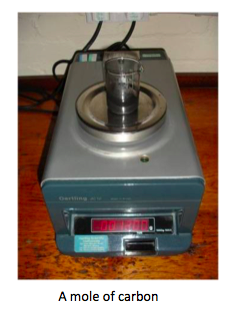Topic 1 : Stoichiometric relationships


 Introduction
Introduction
 This topic on stoichiometry is based on three essential ideas. If you have studied some chemistry before you will probably already know the first - that the physical and chemical properties of substances depend on the ways in which different atoms combine. The second one states that the concept of a mole makes it possible to correlate the (extremely large) number of particles with the mass of the substance that can be measured. The third essential idea is that, by applying Avogadro's law, mole ratios in chemical equations can be used to calculate reacting ratios by mass and gas volume.
This topic on stoichiometry is based on three essential ideas. If you have studied some chemistry before you will probably already know the first - that the physical and chemical properties of substances depend on the ways in which different atoms combine. The second one states that the concept of a mole makes it possible to correlate the (extremely large) number of particles with the mass of the substance that can be measured. The third essential idea is that, by applying Avogadro's law, mole ratios in chemical equations can be used to calculate reacting ratios by mass and gas volume.
In some ways it makes sense to put stoichiometric relationships as the first topic on the syllabus. In the early years of chemistry the formulas of substances were first determined by quantitative analysis. The quantitative work of Lavoisier and others helped to make chemistry a modern scientific subject and moved it away from alchemy. However now that an understanding of chemistry is firmly based on atomic theory many teachers think that it makes sense to learn about the structure of the atom (Topic 2) before tackling Topic 1. This website follows the order given in the IB syllabus but it may well not be the order in which your teacher teaches it.
Many students will put 'Stoichiometry' high on their list of topics that they find most difficult in IB Chemistry. It is an important topic as chemical calculations and the concepts behind them are required in many of the other topics such as rates of reaction, acids and bases and redox chemistry. What this does mean is that throughout the course there will be a steady 'drip feed' of questions and practical assignments involving stoichiometry so that even if you find it difficult at first you will gradually increase in confidence and understanding as the course proceeds.
Associated pages
1.1 Particulate nature of matter and chemical change
After studying this topic you should be able to understand atoms of different elements combine in fixed ratios to form compounds, use use the correct state symbols (s), (l), (g) and (aq) in equations. and deduce chemical equations when the reactants and products are specified...
1.2 The mole concept
After studying this topic you should be able to understand that a mole is a fixed number of particles and refers to the amount, n of a substance, calculate the molar masses of atoms, ions, molecules and formula units and solve problems involving molar quantities...
1.3 Reacting masses and volumes
After studying this topic you should be able to solve problems relating to reacting quantities, limiting and excess reactants, theoretical, experimental and percentage yields and calculate reacting volumes of gases using Avogadro’s law.
The Nature of Science
I received an e-mail from a student (not someone I teach) who asked me, "What is this nature of science business?” So what exactly does the IB mean by the Nature of Science? Essentially it covers five key points...
Topic 1
Many of the references to International-mindedness for Topic 1 relate to the international bodies responsible for the correct use of units (SI system and BIPM) and the naming of compounds (IUPAC). This...

 IB Docs (2) Team
IB Docs (2) Team